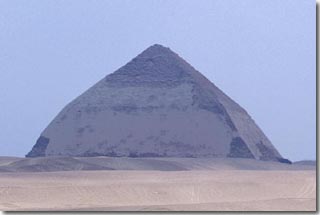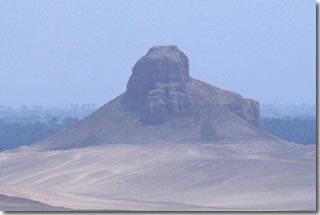| |
||||||
|
||||||
DASHUR PYRAMID FIELD |
||||||
 |
|
|||||
The Bent Pyramid ("Southern Shining Pyramid" to the Egyptians) was built out of locally-quarried limestone. Polished Tura limestone makes up the casing. The casing blocks are very stable and difficult to remove because they slope inwards. The base of the pyramid is 188.6m and is 105m high. Because of the bend in construction, the original angle would have made it 128.5m high. The Bent Pyramid is unique because - obviously - it bends! The slope
degree changes abruptly midway up the pyramid. We have two theories
for this change. The first is that the builders 'rushed the job' and
finished faster by reducing the volume. The second is that the architect
lost his nerve when the pyramid at Maidoun collapsed. The angle at Maidoun
was 52° - same as the lower half of the Bent Pyramid. At the bend,
the angle changed to 43.5° from there to the peak. |
||||||
The Red Pyramid (or "Shining Pyramid"), is the first true pyramid still standing. It gets its name from the reddish or pinkish limestone used in the casing stones. Quick to learn from the mistakes of the Bent Pyramid, this time the king's architects laid a foundation platform of several courses of limestone to prevent the problem of subsidence. The total area of the structure is only slightly less than the Great Pyramid, but since the angle of inclination of the sides is much shallower (43° 22''), it reaches a height of 341 feet. With its construction, Egyptian pyramids left the experimental stage and achieved the distinctive and proper geometric form they would retain until their building ceased. |
 |
|||||
To celebrate its completion, the proud builders added a solid limestone pyramid-shaped capstone, called today a 'pyramidion'. To the Egyptians, it was the benben, the very tip of that mound of creation where the creator god stood when he created the world. Placed on top of these soaring mounds of masonry, it joined the earth with the sky. Few pyramidions from the Pyramid Age survive, possibly because many were gilded with precious metals. The earliest one now known was discovered in fragments around the base of the Red Pyramid. After painstaking restoration, it has been found that each side had a slightly different angle; even with all of their experience in construction, the Egyptians had trouble reaching the top without some readjustments. Nevertheless, the error is extraordinarily small - only 2° over 335 feet, almost 160 courses of stone! Such a minimal readjustment is, in fact, a true testimony to the abilities of Snefru's architects. But with this change in shape also came a transformation of the concept of the afterlife and a modification of the complex necessary to ensure it. The shape and orientation of the pyramid complexes of Snefru's anceseors suggest they looked to the stars, linking their journey to the afterlife with the never-setting circumpolar stars, 'the imperishable ones', as they called them. But while they ascended their staircase to the stellar sphere, Snefru trod a ramp of gleaming white limestone like the sun's rays to heaven. To reinforce this connection Snefru laid out his temples along a new east-west alignment in accordance with the course of the sun. This new emphasis on the sun led to the adoption of an entirely new name, a new manifestation, of the king on his ascension to the throne as the 'Son of Ra', the son of the sun god, a father he would join in the afterlife. Snefru pioneered his new axial design for his resurrection machine at all three of his pyramids, but his son and successors at Giza perfected it.
|
||||||
 |
|
|||||
Home | Nile Valley | Dynasties | Wealth | Divinity | Temples | Hieroglyphs | Mysteries
|
||||||